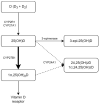Impaired Vitamin D Metabolism in Hospitalized COVID-19 Patients
- PMID: 35893730
- PMCID: PMC9330123
- DOI: 10.3390/ph15080906
Impaired Vitamin D Metabolism in Hospitalized COVID-19 Patients
Abstract
There is increasing data regarding the association between vitamin D and COVID-19. This study aimed to reveal the alterations of vitamin D metabolism in the setting of COVID-19. We examined 119 adult COVID-19 inpatients and 44 apparently healthy adult individuals with similar serum 25OH-D3 levels as a reference group. The assessment included serum biochemical parameters (total calcium, albumin, phosphorus, creatinine), parathyroid hormone (PTH), vitamin D-binding protein (DBP), vitamin D metabolites (25OH-D3, 25OH-D2, 1,25(OH)2D3, 3-epi-25OH-D3, 24,25(OH)2D3 and D3) and free 25OH-D. COVID-19 patients had in general very low vitamin D levels (median 25OH-D3 equals 10.8 ng/mL), accompanied by an increased production of the active vitamin D metabolite (1,25(OH)2D3), estimated as higher 1,25(OH)2D3 serum levels (61 [44; 81] vs. 40 [35; 50] pg/mL, p < 0.001) and lower 25OH-D3/1,25(OH)2D3 ratio (175 [112; 260] vs. 272 [200; 433], p < 0.001) which is presumably aimed at preventing hypocalcemia. Patients with COVID-19 also had elevated DBP (450 [386; 515] vs. 392 [311; 433] mg/L, p < 0.001) and low free 25OH-D levels (<LoB vs. 3.9 [3.2; 4.4] pg/mL, p < 0.001). Follow-up assessment of the COVID-19 inpatients showed recovery of the observed changes. Overall, hospitalized patients with an acute course of COVID-19 have not only very low levels of 25OH-D but also profound abnormalities in the metabolism of vitamin D regardless of the clinical course of the disease. These alterations might exacerbate existing vitamin D deficiency and its negative impact.
Keywords: COVID-19; SARS-CoV-2; vitamin D; vitamin D-binding protein.
Conflict of interest statement
The authors declare no conflict of interest. The funders had no role in the design of the study, in the collection, analyses, or interpretation of data, in the writing of the manuscript, or in the decision to publish the results.
Figures




References
Grants and funding
LinkOut - more resources
Full Text Sources
Miscellaneous

